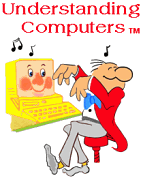
e-Learning/ Computer Basics
from Competence Software
Outline of The Understanding Computers™ Course
The Understanding Computers Course contains 8 sections and 35 lessons. A quiz follows each section. When a student gets an incorrect answer, the program provides the correct answer for the student before he goes on to the next question. At the end of each quiz, the student is advised to return to the areas of that section where questions were missed to restudy that material. When the course is completed and all the quizzes passed, the student can request a certificate of completion (suitable for framing) from Competence Software.
Highlighted sections are linked to free demonstrations of educational content. The demos require a free player from Macromedia. If you have trouble viewing any of the definitions (in highlighted blue) then click the button below and follow the simple instructions to download.

Section One – Introduction
Covers the definition, purpose and functions of a computer.
- 1.1 Welcome
- 1.2 Computer Definition #1
- 1.3 Computer Definition #2
- 1.4 Course Program
- 1.5 Skill
Section Two – History
Includes the major milestones in the evolution of computers from Pascal in 17th century France to the first electronic computer.
- 2.1 Pascal’s Machine
- 2.2 Babbage’s Machine
- 2.3 Punch Cards
- 2.4 The First Electronic Computer
- 2.5 The von Neumann Machine
Section Three – Instructions And Numbers
You will learn how computers operate internally, manipulating numbers and decoding human instructions into binary language (1s and 0s) which is the only language that computers really understand.
- 3.1 Precise Instructions
- 3.2 The Two-Fingered Aliens
- 3.3 Humans are from Earth, Computers are from Twoth
- 3.4 Agreements
Section Four – Inside the computer
Takes you inside the heart of a computer and shows you what makes the computer "tick."
- 4.1 Pigeonholes
- 4.2 The Active Agent
- 4.3 Algorithms Inside
- 4.4 The Lesser Agents
- 4.5 The von Neuman Machine (again)
Section Five – Programming Languages
Covers the various languages that are used to give the computer the precise instructions it needs to perform jobs such as payroll processing and flight reservations, solve engineering problems, deliver information useful in running a business, handle communications, entertain, etc.
- 5.1 The Machine Language Blues
- 5.2 A Higher-Level Language
- 5.3 A Language for Business
- 5.4 Man-Machine Communication
Section Six – Computer Systems
Covers the role of the operating system which keeps the computer busy producing for the user. Includes the evolution of the operating system to meet the needs of multiple users who ask the computer to do different tasks simultaneously.
- 6.1 The Bottleneck
- 6.2 No Waiting
- 6.3 Interactive Systems
- 6.4 Organizing Information
- 6.5 Transaction Processing
Section Seven – Personal Computers
Explores the role and evolution of personal computer systems from the difficult to use character oriented systems to the intuitive modern day graphical user interface systems. Includes the function and operation of networks and “servers".
- 7.1 Service for One
- 7.2 The IBM PC
- 7.3 Service for Many
- 7.4 Improved Communication
Section Eight – Conclusion
This final section ties it all together. Summarizes the functions of all the various parts, shows how they work together and clears up all those technology terms that are used to describe the performance and capacity of computer systems.
Back to Understanding Computers page.
|




